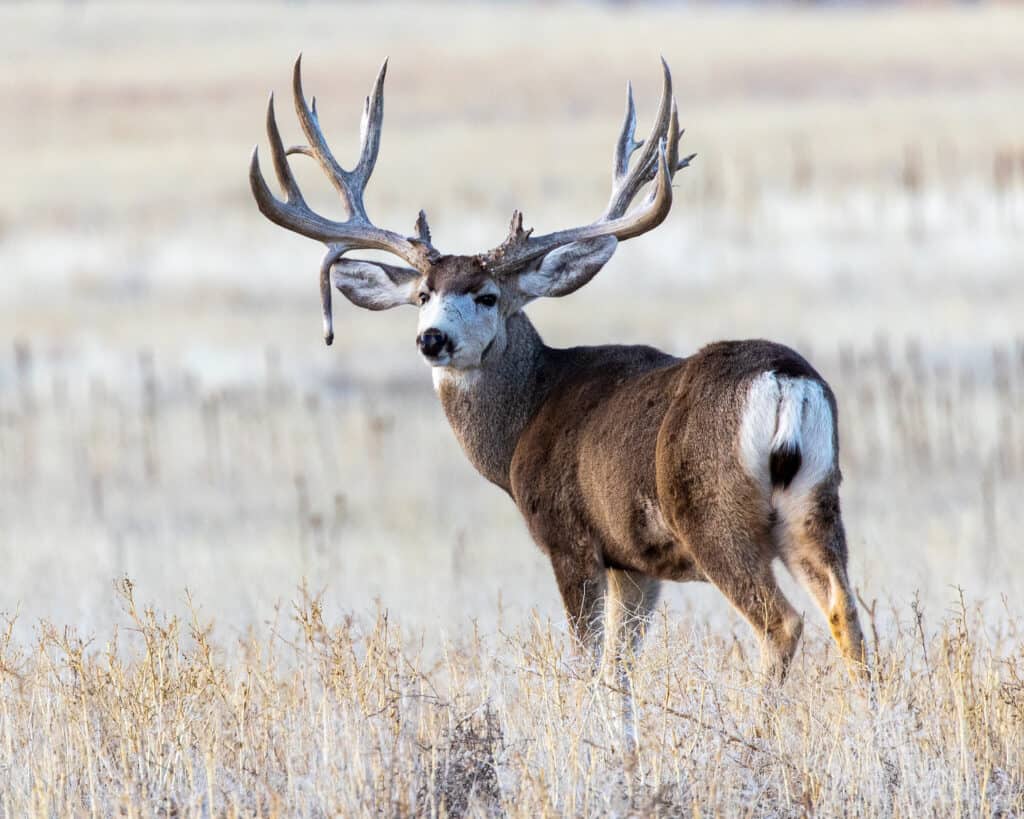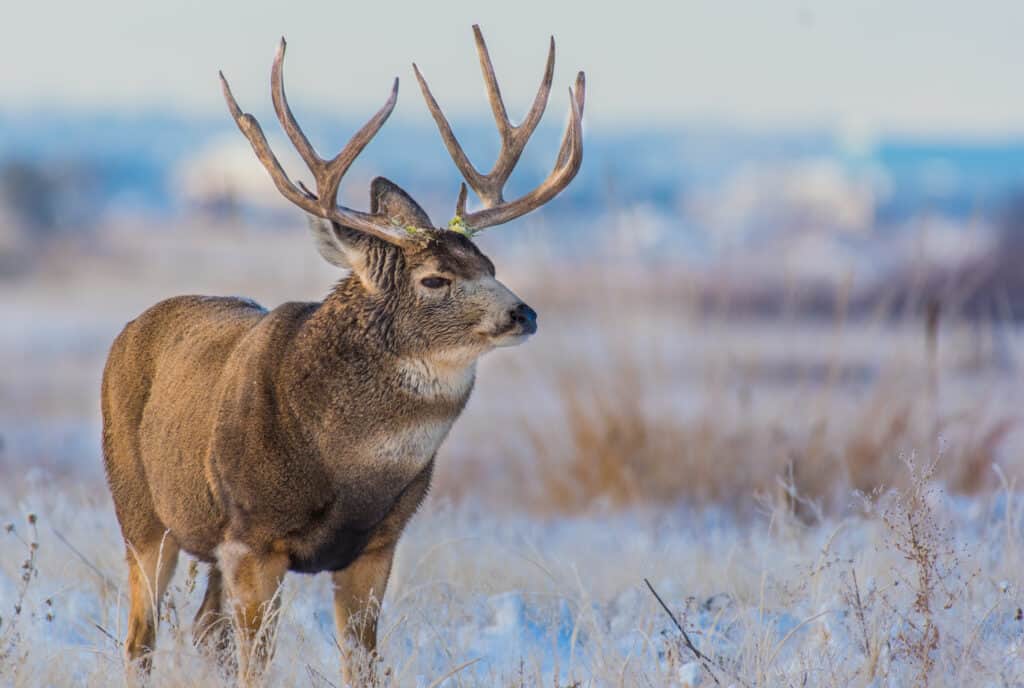The mule deer (Odocoileus hemionus) is a highly recognizable and beloved Western North American icon. Western Great Plains, Rocky Mountains, and Pacific Coast (including Alaskan islands and southern Baja California) are common environments for these animals. Mule deer thrive in the dry, rocky conditions that characterize much of the American West.
The ears of a mule deer are around three-quarters the length of the head, making them a distinguishing feature of the species. They stand out from the crowd with their grayish skin and dark black forehead, or mask. Mule deer are brownish in the summer and brownish-gray in the winter.
How Many Mule Deer Are There in the Wild?

The velvet’s primary function on a mule deer is to supply the cartilage with oxygen and required nutrients.
©iStock.com/Jeff Edwards
Over four million mule deer live in the Western United States, with blacktails making for over half of that amount. Between 400,000 and 450,000 mule deer call Colorado home. This makes it the state with the highest concentration of recorded mule deer.
As a result of shifts in habitat, predators, disease, hunting guidelines, and environmental circumstances, researchers predict that mule deer populations will continue fluctuating across the continent.
Main Factors that Impact the Mule Deer Population

Droughts reduce food availability and
antler
size and cause higher mortality rates in Southwest mule deer.
©iStock.com/twildlife
Moisture
Given the widespread distribution of this species, environmental parameters like precipitation shift from year to year and region to region. Drought years in the Southwest lead to hunger, smaller antlers, poor health, and greater mortality rates. Wet years result in more fawns and larger antlers.
Cold
Meanwhile, young deer are especially vulnerable to the harsh winters that can hit the Northern Rockies. Mule deer survival rates in Colorado, Idaho, and Montana that the annual growth rate of a herd is very sensitive to fluctuations in the number of fawns that survive to adulthood. However, adult doe survival was unaffected by the same conditions. Winter fawn survival is mostly driven by the annual climate shifts that are characteristic of the region.
Fires
In some arid parts of the Southwestern United States, fires frequently burn off native flora, leaving areas open to plants that deer steer clear of. Intense heat from these blazes has the potential to sear soils, deplete mineral content, and result in minimal regrowth.
However, fire can actually promote the bountiful growth of herbs, shrubs, and even young trees in hilly areas. A good example is the “Bulldog Fire” of 2003. It benefited mules by clearing up more than 30,000 acres of range in the Henry Mountains in southeast Utah. According to data given by WAFWA, the number of fawns born per 100 does’ increased from 44 to 80 as a result of the fire’s promotion of high-quality forage. The antlers of bucks also grew in size and researchers found that their body fat percentage had risen.
Hunting
Mule deer hunting is popular among sportsmen because it is at a low cost compared to hunting other Western large game. Over-the-counter mule deer tags are available annually in many states. Some units are available through draw tags as well.
The Evolution of the Mule Deer Population

The mule deer population has increased since it was thought to be almost extinct in the late 1800s.
©iStock.com/Kerry Hargrove
Mule deer populations recovered from near extinction in the late 1800s due to excessive livestock grazing, subsistence, commercial hunting, and extended hard weather.
1920s to 1940s
After the shooting was curtailed and predators were ruthlessly eradicated in the 1920s and 1930s, deer populations exploded. Like whitetails, mule deer thrive in disturbed ecosystems like those created by the massive cutting of large forests, the suppression of wildfires, and the grazing of cattle on grasslands. By the 1940s, deer populations had grown to their highest levels in the modern era.
1950s to 1960s
The massive herds that we maintained in the 1950s and 1960s were unsustainable. Overbrowsing, decreased logging, slowly aging forests, and active fire control all contributed to deteriorating habitat conditions by the late 1960s. Meanwhile, fawn mortality was increased by severe winter weather in the north and widespread dryness in the desert southwest.
1970s to 1990s
Disease, predators, poachers, decreasing habitats, competition with elk, and whitetails all contributed to continued declines in deer populations throughout the 1970s. Many mule deer populations recovered during the 1980s. However, the mule deer’s third broad drop in modern history was initiated by droughts in dry parts and hard winters in mountain regions later in that decade.
In the 1990s, mule deer populations declined across the United States and Canada as a result of a “perfect storm.” Since the extinction affected mule deer over their entire range, it was formerly thought that a single factor was to blame.
Are Mule Deer Going Extinct?
Mule deer populations fluctuate constantly, as evidenced by historical records. Historical patterns do not foresee the extinction of the Mule deer any time soon, despite the fact that their numbers tend to regularly vary due to a variety of circumstances.
The photo featured at the top of this post is © Kirk Geisler/Shutterstock.com
Thank you for reading! Have some feedback for us? Contact the AZ Animals editorial team.






